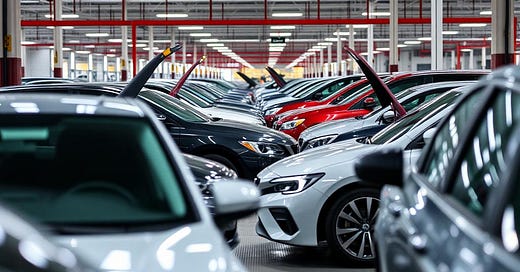Since opening up its economy, China has benefitted tremendously from international linkages and a free flow of capital, talent and technological know-how. While foreign firms gained from China's manufacturing prowess, cheap labour and economies of scale, China could leverage access to its large and fast-growing economy to force technological transfers via joint ventures with Chinese firms - as captured by the phrase "Trading Market for Technology". But China's aspirations for self-reliance and ambitions to advance itself have, over the years, led to a double whammy for these foreign firms. First, they get squeezed out of China's domestic market and eventually find themselves at a competitive and cost disadvantage in their key international markets - a Faustian bargain, as Kyle Chan puts it.
As industry veteran Michael Dunne pointed out, this is currently playing out in the automobile industry. BMW, Toyota, and Volkswagen are only a few automobile manufacturers that swarmed into the Chinese market, milking it for billions of dollars in profits. But this is no longer the case. Sales of foreign manufacturers have been consistently plummeting, and more sophisticated domestic alternatives are cropping up in their place. Globally, BYD recently overtook Tesla in EV sales, topping over a hundred billion dollars in revenue.
Behind the exuberant fanfare about global domination, increasing exports, and increasingly "intelligent" driving systems is an industry in flux. This article struck me as a good read about the state of China's auto industry, confirming my previous assumptions.
Firstly, these firms have been engaging in price wars, resulting in a reported profit margin of 4.3% which is lower than the national average of 6% for all industrial enterprises. Reportedly, less than 40% of the automobile companies made money last year and at least a thousand dealership stores have been shut down. Abandoned EV farms, termed “graveyards”, are telling of the Chinese model — subsidy-linked boom, increased entrepreneurial activity, followed by fierce competition and industry consolidation via forced acquisitions and brutal shutdowns.
In the auto sector, increased competition and tighter margins have led to exaggerated marketing on the part of manufacturers. For example, slogans such as "zero takeovers throughout the process" and "safer than human drivers" have caused confusion between "assisted" driving and "autonomous" driving, with serious consequences for consumer safety. Multiple cases of system failures leading to accidents and deaths have been reported recently. Early April brought news about a fatal car crash in Xiaomi’s EV system that was followed by public outcry and investigation. By mid-April, the Ministry of Industry and Information Technology had prohibited automobile firms from using several such expressions in their marketing campaigns.
Additionally, the guideline also signalled more stringent regulation -
The ministry has banned the standard industry practice of using “pioneer user” beta testing programs. Officials stated that “public testing, whether with thousands or tens of thousands of users, must go through official approval channels.” This effectively ends the smartphone-inspired approach where automakers recruited early adopters to test and provide feedback on new autonomous driving features.
Functions that operate without driver supervision—including valet parking, one-touch summoning, and remote control features—are now prohibited. The ministry emphasised that “these functions will not be approved for products” as they cannot ensure driver engagement and operational safety.
The regulations mandate that driver monitoring systems cannot be disabled and must detect when drivers remove their hands from the steering wheel. If hands-off detection exceeds 60 seconds, the system must implement risk mitigation strategies such as slowing down, activating hazard lights, or pulling over.
MIIT criticised frequent over-the-air updates, stating that one goal of the new regulations is to “reduce frequent OTA updates and improve version risk management.”
More recently, there have been some ideas as to how to control such behaviour — called “involution-type competition” — on the part of firms across sectors. You can more about this here.
In the words of State Administration for Market Regulation (SAMR) Party Secretary and Director Luo Wen,
… Phenomena such as low-price, low-quality, and low-level competition are increasingly spreading. Illegal activities such as unfair competition and infringement and counterfeiting occur frequently and intensively, seriously distorting market mechanisms and damaging the order of fair market competition. We must deeply understand the harm of ‘involution-type’ competition …
Enterprises face innovation bottlenecks, which not only leads to resource waste and low efficiency but also hinders industrial structural optimization and upgrading, and runs counter to the requirements of developing new quality productive forces.
He suggests a comprehensive set of policies including strengthening of Intellectual Property Rights, cracking down on counterfeits, implementing a fair competition review system, promoting “self-discipline” and “legal competition”, leveraging national standards, etc.
However, there are structural impediments to these changes and change of any kind is bound to be slow. When the dust settles - a "tidying up" of the industry - and the market eventually consolidates, the winners from the automobile sector’s brutal competition are likely to be even more world-beating. This is likely to have implications for the global economy, so brace yourself!





